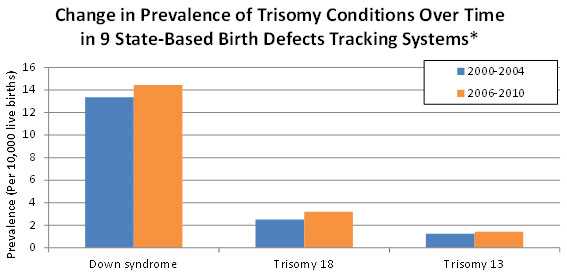Key Findings: Frequency of Trisomy Conditions using Birth Defects Tracking Programs in the United States, 2006-2010
Frequency of Trisomies
The journal Birth Defects Research Part A has published a new report on the frequency of trisomies, which are conditions that occur when an extra chromosome is present (resulting in 47 chromosomes instead of the typical 46). Researchers from CDC and state-based birth defects tracking programs through the National Birth Defects Prevention Network reported the most common trisomy is Down syndrome (also called Trisomy 21) with a prevalence of 14.2 per 10,000 live births from 2006-2010. There are three trisomy conditions in the report—trisomies 13, 18, and Down syndrome— and all three have been increasing over time. You can read the article here.

Boy with Down syndrome, the most common trisomy condition
Main Findings from this Study
- The most common trisomy condition is Down syndrome (also called Trisomy 21) with a prevalence of 14.2 per 10,000 live births from 2006-2010.
- The prevalence for trisomy conditions varies by state, mostly due to differences in how tracking programs collect data.
- The prevalence of trisomy conditions has increased over time.
- The prevalence of trisomy conditions increases as mother’s age increases.
Note: Unless otherwise noted, the estimates shown here are based on data reported from 12 state programs that look for trisomy conditions among all pregnancies.

*Only states that reported for both periods were included. This figure is based on data from 9 birth defects surveillance programs: Arkansas, Colorado, CDC/Georgia, Iowa, North Carolina, Oklahoma, Puerto Rico, Texas and Utah.

About this Study
- Purpose: Each year, state-based birth defects tracking programs report data on over 40 major birth defects in their state to the National Birth Defects Prevention Network and CDC. In addition to the published state-specific data, a particular birth defect or group of similar birth defects is highlighted in a brief data report based on pooled data from participating states. This year, the brief data report focuses on the most common trisomies, conditions that occur when an extra chromosome is present (resulting in 47 chromosomes instead of the usual 46) and includes data from 40 state-based programs.
- Data collection: Tracking systems may use different methods to find babies with birth defects and confirm the diagnoses. Also, about one-third of the state birth defects programs look for birth defects among live births only, one-third look for birth defects among live births and stillbirths, and the remaining one-third look for birth defects among all pregnancy outcomes. This data report attempts to group data that were collected in a similar way to better understand the birth prevalence and changes over time.
CDC activities: Trisomies
- Tracking: Tracking where and when trisomies occur and the individuals they affect gives us important clues about opportunities to improve health outcomes and plan for services for affected families.
- Research: CDC is working with the National Birth Defects Prevention Network to examine survival among those born with trisomy 13, 18, and Down syndrome.
More Information
For more information about birth defects, please visit www.cdc.gov/birthdefects.
For information about the National Birth Defects Prevention Network, visit www.nbdpn.org
For more information about Down syndrome, please visit www.cdc.gov/ncbddd/birthdefects/downsyndrome.html
Key Findings Reference
Mai C, Kucik JE, Isenburg J, et al. Selected Birth Defects Data from Population-based Birth Defects Surveillance Programs in the United States, 2006-2010: Featuring Trisomy Conditions. Birth Defects Res Part A. 2013;97(11):709–25.
- Page last reviewed: October 21, 2014
- Page last updated: October 21, 2014
- Content source:


 ShareCompartir
ShareCompartir